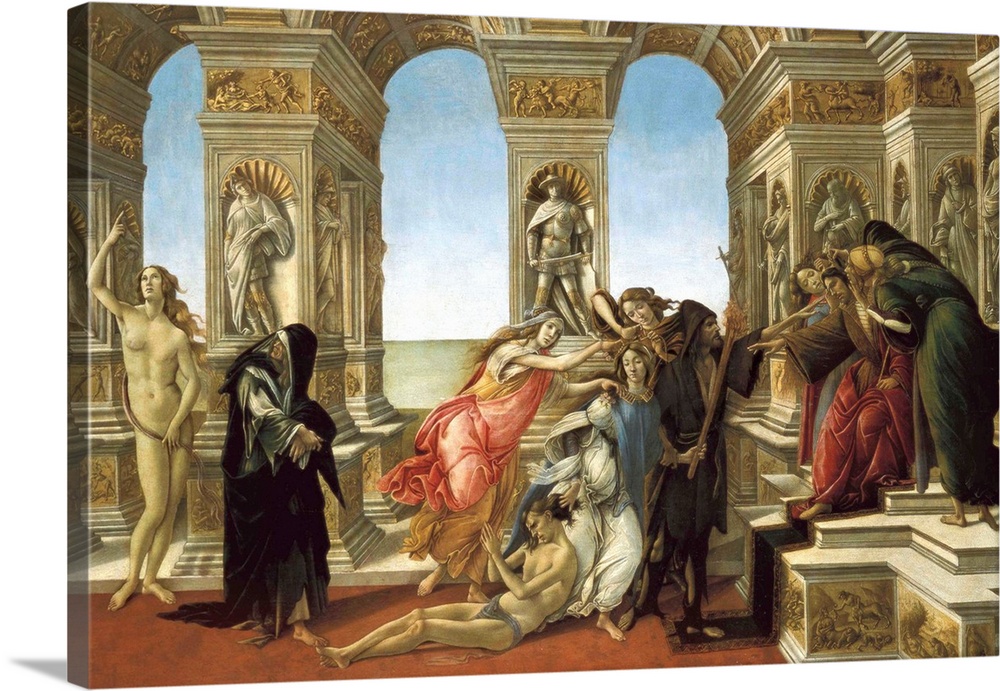
The Calumny of Apelles Wall Art, Canvas Prints, Framed Prints, Wall
The Calumny is an allegorical painting that ancient painter Apelles had made to defend himself from a false accusation of conspiracy against King Ptolemy. A lost ancient panel remembered by Lucian of Samosata that Sandro Botticelli reinterpreted at the end of the 15th century as a new Apelles. A complex iconography that can be read from right.

The Calumny of Apelles Saint Louis Art Museum
Calumny of Apelles is a significant fresco from Botticelli's distinguished career, arriving in 1494-1495. This tempera on panel artwork stands at 62 cm by 91 cm and features both anatomical figures and sculptured architectural details. There is a breadth of activity across the work, providing several items of symbolic and mythological.

Calumny of Apelles Sandro Botticelli 1494 silver and exact
The Calumny of Apelles Sandro Botticelli Florentine painter, c1445 - 1510 Jpg: courtesy of Giorgio Vasari pages. Although none of the work of Apelles has survived (he lived in the 4th century BC), he is lavishly praised and his works described by Pliny in his Natural History. And, as the 3 or 4 books of the Natural History that deal with art.

Calumny hires stock photography and images Alamy
Featured: Rhombicuboctahedron by Leonardo da Vinci. mythological painting. The Calumny of Apelles is a tempera painting by Italian Renaissance painter Sandro Botticelli. Based on the description of a painting by Apelles, the work was completed in approximately 1494. It is on display in the Uffizi in Florence .

The "Calumny" of Apelles
The Calumny of Apelles is a panel painting in tempera by the Italian Renaissance painter Sandro Botticelli.Based on the description of a lost ancient painting by Apelles, the work was completed in about 1494-95, and is now in the Uffizi, Florence.. The content of Apelles' painting, as described by Lucian, became popular in Renaissance Italy, and Botticelli was neither the first nor last.

Calumny of Apelles Sandro Botticelli Canvas
The Calumny of Apelles Place Italy (Artist's nationality:) Date Dates are not always precisely known, but the Art Institute strives to present this information as consistently and legibly as possible. Dates may be represented as a range that spans decades, centuries, dynasties, or periods and may include qualifiers such as c. (circa) or BCE.
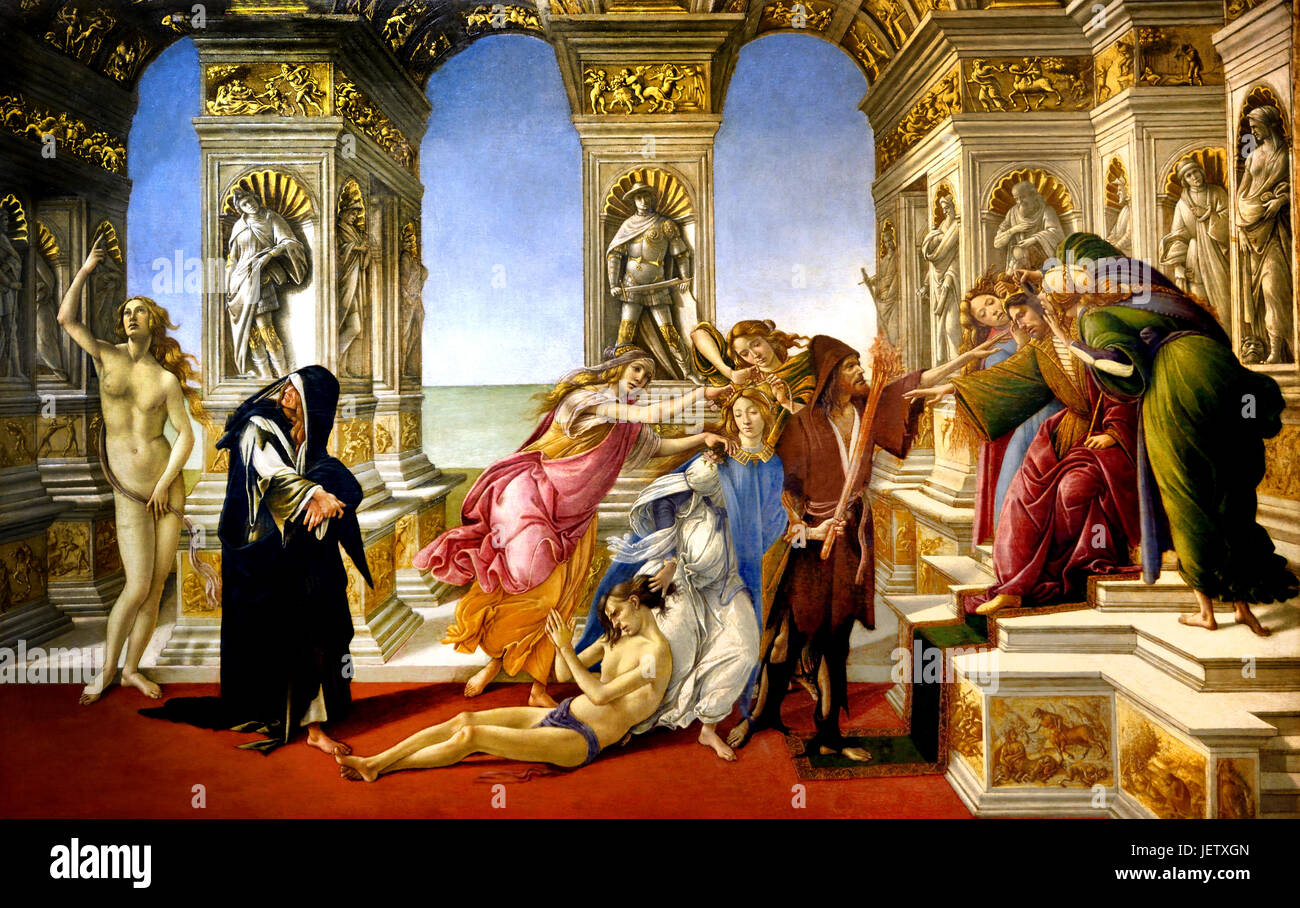
Calumny of Apelles 1495 Sandro Botticelli ( Alessandro di Mariano
Calumny of Apelles. This unusual late scene by Botticelli has an almost surrealistic quality to it, with its ornate setting, blank skies and allegorical figures. The work is the result of Botticelli's attempt to recreate a lost painting by the Ancient Greek artist Apelles, as described in a well-known text by the Roman writer Lucian, pointing.
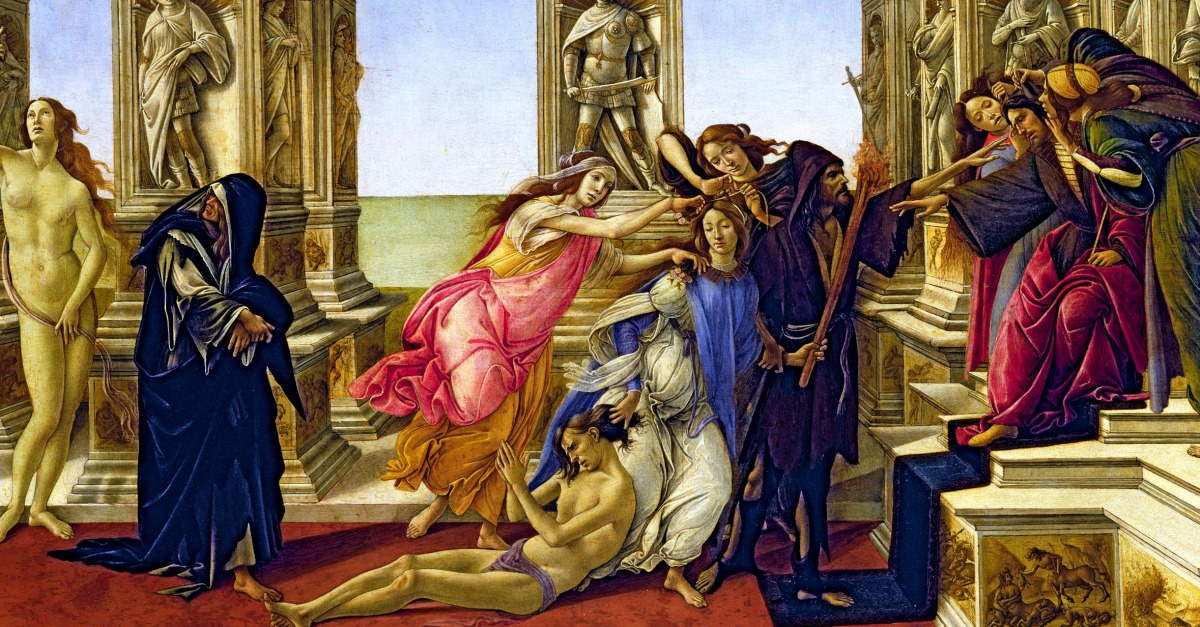
Swindle & Fraud The Calumny of Apelles Lapham’s Quarterly
Calumny of Apelles, 1494 by Sandro Botticelli. Click Image to view detail. The last painting in which Botticelli was to take a secular story as his subject is The Calumny ofApelles. The observer is surprised both by its relatively small size - a mere 62 x 91 cm - and by the miniature-like fine painting technique.
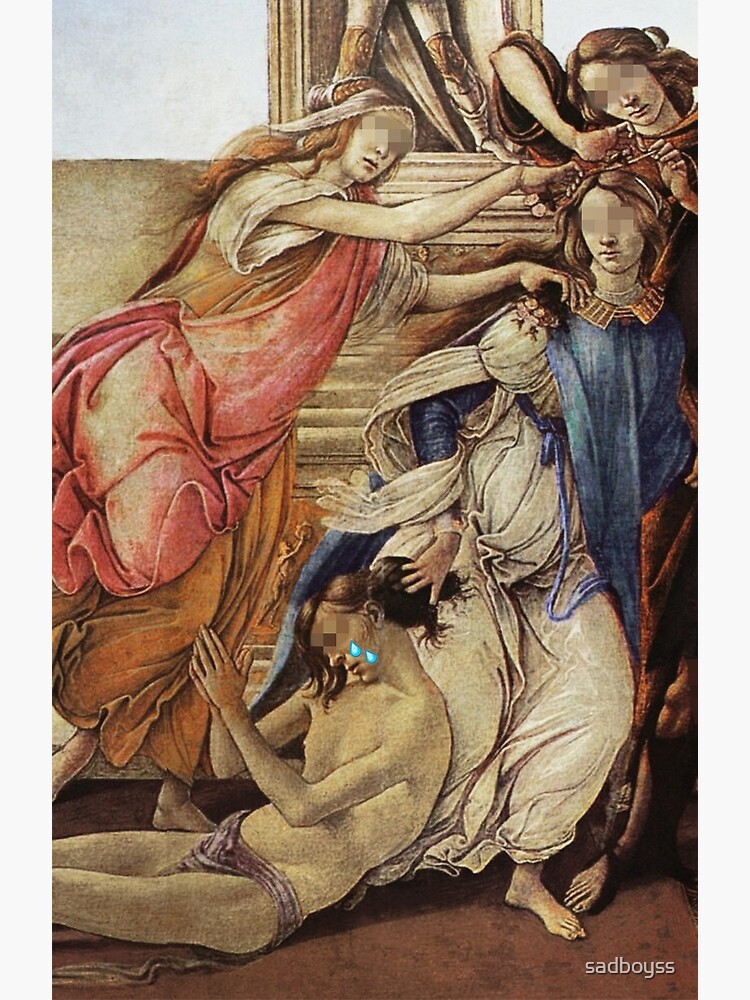
"Calumny Of Apelles (1495) {SAD ART}" Poster by sadboyss Redbubble
The work that best illustrates Botticelli's interest in reviving the glories of Classical antiquity is the The Calumny of Apelles (c. 1495), a subject recommended by Alberti, who took it from a description of a work by the ancient Greek painter Apelles. Botticelli also drew inspiration from Classical art more directly.

"Calumny Of Apelles (1495) {SAD ART}" Poster by sadboyss Redbubble
The Calumny of Apelles is a tempera panel painting by the Italian Renaissance painter Sandro Botticelli. Based on the description of an ancient lost painting by Apelles, the work was completed in about 1494-95, and is now in the Uffizi, Florence.

Botticelli Calumny of Apelles Glass art
Botticelli's masterpiece "The Calumny of Apelles" was painted when the artist suffered a severe existential crisis which would change forever his style and the subjects of his works. Therefore, "The Calumny of Apelles" is a divide between the first and the second phases of Botticelli's artistic production. READ ALSO - The Birth of.

PhotographThe Calumny of Apelles, End 1590s. Creator Vos, Maerten, de
The Calumny of Apelles; at left the seated judge, wearing a crown and with large ears, and at right a group of women including one dragging a child by the hair Pen and brown ink, with brown wash Producer name Drawn by: Andrea Mantegna. School/style Paduan. Production date 1504-1506. Materials paper. Technique drawn. Dimensions.

The Calumny of Apelles. Found in the Collection of Galleria degli
The Calumny of Apelles. This superb impression is based on an ancient description of a lost allegorical painting by the Greek artist Apelles. The lost painting, known as The Calumny of Apelles, expresses truths about calumny, or the telling of lies to ruin someone's reputation. Apelles painted it after he himself had nearly been put to death.

Calumny of Apelles (Botticelli) The Calumny of Apelles is … Flickr
This allegory of injustice, popular with Renaissance artists for its moral content, is based on a written description of a lost painting by the ancient Greek artist Apelles. An enthroned judge with large ears is flanked by Suspicion and blindfolded Ignorance. He extends a hand to Calumny (Slander), who, helped by Envy, drags a young man by the.

Calumny of Apelles Teatro Maria Matos
The Calumny of Apelles is a tempera panel painting by the Italian Renaissance painter Sandro Botticelli. Based on the description of an ancient lost painting by Apelles, the work was completed in about 1494-95, and is now in the Uffizi, Florence. The content of Apelles' painting, as described by Lucian, became popular in Renaissance Italy.
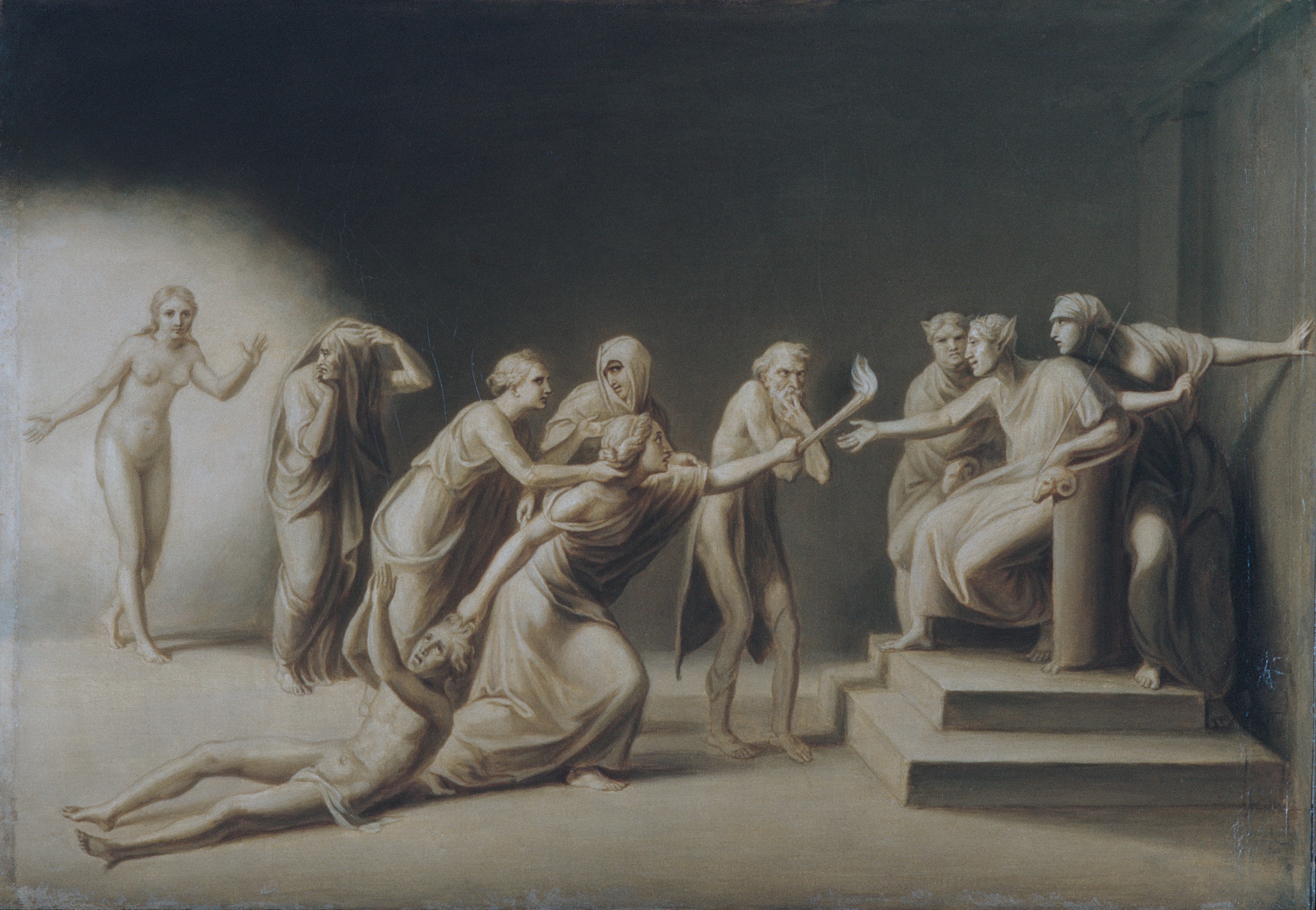
John Vanderlyn The Calumny of Apelles American The Metropolitan
Masterpiece Story: The Calumny of Apelles by Sandro Botticelli. Sandro Botticelli, The Calumny of Apelles, 1495, Uffizi, Florence, Italy. Botticelli's final painting with a mythological subject is based on a lost painting by an ancient Greek painter Apelles. He ventured to paintwork according to a description provided by Lucian in his Dialogues.